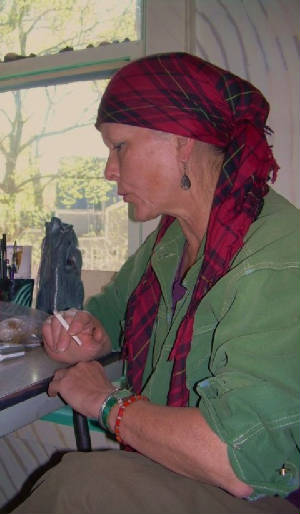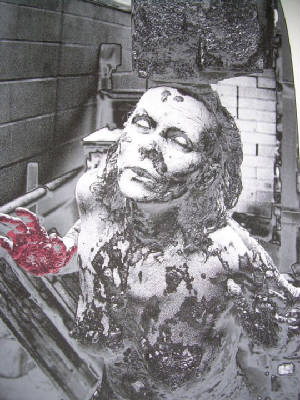|

|
| Sniedze Rungis |
Love is not an emotion. Love is an electromagnetic energy field … when love functions,
there is no subjugator nor the subjugated.” – Sniedze
Rungis on radical love according to the teaching of Jesus Christ.
Sniedze Rungis: Art as Activism and Antidote
by Jeanette Lee
Art as activism depends on
the artist. Sniedze Rungis’ “current response to a damaging epidemic in our country” (that is, the plague
of pornography and the sex industry: a multi-billion-dollar profit-making venture) is Survivor (Stations of the Cross). Survivor is an artist’s book conceptualized
as a Holocaust memorial by Sniedze and photographed by James Riegel.
Sniedze’s art creates connections to this “contemporary spiritual holocaust” and confronts the question:
How do we approach this issue without allowing it to consume us? Sniedze says, “We can do something about it if we join together, as always.”
Sniedze’s parents fled
their homeland of Latvia to escape the Soviet army during WWII. Sniedze was born in a Displaced Persons
camp in Germany. When Sniedze was six
months old, her family emigrated to Midwestern United States. Sniedze and her family maintained their roots in Latvian culture
and heritage (Sniedze speaks, reads and writes in Latvian and is a well-known artist and poet in the Latvian community) while
developing new roots in Michigan. Sniedze’s art, like
Survivor, is informed by her family’s loss and displacement because of the
Soviet occupation of Latvia.

|
| Survivor by Sniedze Rungis |
Survivor is a dramatized and photographed recreation of a woman’s journey
through a Third Reich death camp. The woman (portrayed by Sniedze) is naked – like the millions that passed through
the industrialized mass murder system. She is captured in movements symbolically replicating the Stations of the Cross, while
following the path of a Holocaust victim through the death camp. “If people choose to view this in a salacious manner,
they need to seek professional help,” the artist states.
Survivor originated with Sniedze’s desire to differentiate the erotic spark
of art from the flat perversion of pornography. The project opens with an introduction by Sniedze, next to a copy of a photograph
from a pogrom in Lemberg, Austria in 1942. In the
image we see an unprotected woman: she is naked, seated on the cement, surrounded by German functionaries – all fully-clothed
males. Survivor is dedicated to this anonymous woman.
The
sequential experience of the photos reminds the viewer the
body is the soul’s friend, its sanctuary. While creating Survivor, Sniedze intentionally invoked images of Buddha’s face – “retaining
consciousness even in hell.” In addition to the facial expressions of Sniedze, the soul in Survivor is visually evident by intentional points of light in the black and white photographs.

|
| Sniedze Rungis with Folio 0003 photo by Zinta Aistars |
The hand-crafted wooden boxes (marked with black numbers, 0001, 0002, 0003, 0004) housing the Survivor folio replicate Trench Art, which is art made with objects collected
from areas of military conflict. Folios 0001, 0002 and 0004 are distributed amongst the Occupation Museum of Riga, Latvia;
The Moscow Holocaust Museum; and the Detroit Holocaust Memorial Center. Folio 003 is currently in
Kalamazoo, Michigan.
Inside each box is a reptilian-leather-clad book. Sniedze chose the silvery-black leather because it was reminiscent of the
leather employed in the visually imposing SS trench coats. Inside the box, to the left of the book, is a small compartment
containing a pair of wire-rimmed spectacles and a pair of white gloves stained with red, creating the aura of an exhumation.
Sniedze
is interested in developing a theatrical tour with a potential Survivor exhibit. By incorporating spoken word with her artist’s book, she hopes to elucidate the present pornography
pandemic plaguing our nation and it’s correlation with the Holocaust.
How
is the epidemic use of pornography akin to the danger of the Holocaust?
In both humans are objectified in order to provide a rush of power to the perpetrator. Pornography desensitizes to acts of
dehumanization--the same brain washing process used by the Nazis preceding and during the Holocaust.
Sniedze notes both women’s and men’s attitudes toward modesty, how it used to be: for a woman, modesty
was not only protection, but an inner attitude. And a man’s greatest strength is gentleness. At the root of society’s complacency to dehumanization, “is
our separation from nature and our natural being.’ Referring to the epidemic of ‘sexting,’ she says, “We
seem not to be able to teach our children that their bodies are sacred.”

|
| Star Girl by Sniedze Rungis |
After creating Survivor, Sniedze completed a project called Stargazer: a photo series integrating images of sacred spaces in Latvia
with cosmic images from the Hubble telescope. This focus on divine creation
in Sniedze’s art is her antidote to Survivor. She felt compelled to attain
equilibrium between her internal and external being, and to recall the spiritual in a time of spiritual drought. The medium
of her art depends on where she is in her life at that moment of creation, and what resources are available. “It takes
time to hear the inspiration, it takes solitude and silence.”
Next on the agenda for Sniedze is an exhibit at the Embassy of Latvia in Washington D.C. The Explorer
Series will debut at the Latvian Embassy in September 2010. Explorer is a compilation of photos from her expedition to the sacred spaces/holy places in
Latvia. Explorer embodies the persona
of the explorer recovering our cosmic bond. Reflecting her Latvian heritage, at the inaugural exhibit of Explorer, Sniedze
will ask women to wear traditional Latvian jewelry, which incorporates the sacred geometry that represents natural and cosmic
powers.
Sniedze Rungis has a BFA from the Art Institute of Chicago. Formerly, she apprenticed
with The Whole Art Theatre in Kalamazoo, Michigan,
between 1984 and 1992 under the theatre’s founder and director, Dr. Werner Krieglstein. Sniedze went on to become the
theatre’s
artistic director from 1992 to
1997, as well as coordinator of Mascaras y Manos,
a theater program for children of migrant workers. She presently works full time as a visual artist in Kalamazoo, Michigan. Learn more about the art of Sniedze Rungis.
|

